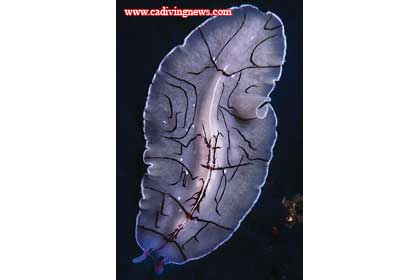A rather stunning creature grabbed my attention. It was off-white with ostentatious black, purple, and red lines that zigzagged down its back. It looked like and moved like a nudibranch, but lacked the gills and rhinophores of a nudibranch. What could it be?
Turns out my mystery critter was a flatworm. Flatworms belong to the Phylum Platyhelminthes, a group that contains some very primitive, and yet very beautiful, animals. This name derives from the Greek and literally translates to “flat worm.” Platyhelminthes have been divided into three classes, and two of these contain worms that are entirely parasitic. These are the tapeworms that torment domesticated animals and sometimes humans. The free-living flatworms are grouped into the Class Turbellaria.
There are about 4,500 different species of Turbellaria, and these are exceptionally simple animals. They are generally small, four one hundredths of an inch to one inch, but a few can grow to over one foot. Flatworms have no circulatory or respiratory system–they are small enough to exchange oxygen for carbon dioxide directly through their skin. They have a very primitive nervous system, consisting of a concentration of nerves towards their head. Their digestive system is equally simple, and consists of a mouth located in the center of their bodies and a branched digestive organ. They have no anus and indigestible material is expelled out of their mouths. Flatworms do have eyes, usually mounted on short stalks. Their vision is not particularly good; they are probably only able to distinguish light from dark, and moving shadows.
Flatworms are hermaphroditic–they have both male and female sex organs. However, they need a partner to reproduce, since they cannot fertilize themselves. Eggs are fertilized internally and then deposited onto the reef substrate in gelatinous strands. Some eggs hatch directly into small worms; others first appear as pelagic larvae, and then develop into adult worms. Within this class there is only one group that is large enough for divers to observe–the Order Polycladida. The polyclads are mostly marine worms, although there are a few fresh water species. There are at least 42 species of polyclad worms in our California coastal waters. Most of these species tend to be brilliantly colored with a wide array of individual colors, and intricate color patterns. They are among the most colorful of our marine invertebrates. Their outrageous coloration serves as a warning to hungry fish since these flatworms concentrate chemicals that are very distasteful, if not very toxic.
The polyclad I described earlier was in fact Eurylepta californica, and has no common name. They are found along the entire California coast in shallow water, as well as in the intertidal region. This polyclad is relatively uncommon and was about 1 and ¼ inches long and a half-inch wide.
Like most polyclads Eurylepta spend most of their life under rocks and emerge at night or cloudy days to feed. These worms are carnivores and feed on many kinds of small animals including copepods, amphipods, isopods, and encrusting bryozoans. Polyclads are capable of extending their stomach and engulfing their prey, and can consume animals almost as big as themselves.
Polyclads are commonly observed in the tropical Pacific because they tend to be out and about during the day. However, in California’s waters they tend to hide during the day and come out at night. In Central California the Monterey Breakwater and the other spots along Cannery Row are good spots to look for flatworms; the protected shallow waters around Catalina Island is another. They are about the size of a small nudibranch, but are completely unrelated and often are even more intricately colored.
Remember to look for these brightly colored invertebrates during your next night dive. If looks like a nudibranch, but has no gills, it is probably a flatworm.










